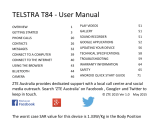
• Brightness level: Move the slider to adjust the brightness level
on your device.
• Adaptive brightness: Turn on adaptive brightness to automatically
optimize the brightness level on your device based on the available
light around you. Adaptive brightness is on by default. You can
adjust the brightness when needed.
• Sleep: Change how long it takes for your device’s screen to go
black when you’re not using it. Learn more about Sleep Settings.
• Daydream: Set up screensavers that display photos, colorful
backgrounds, and more when your device is charging or docked.
Learn more about using Daydream.
• Ambient display (available only on newer Nexus devices): Turn on
ambient display if you want your phone to wake up when you pick it
up or when a notication arrives.
Sound and notication
To change the sound and notication settings on your device, go to
Settings
> Device > Sound & notication .
Notications alert you to the arrival of new messages, calendar events,
and alarms, as well as ongoing events, like downloads:
• Do not disturb. These settings allow you to control which notications
come through at certain times of day or on different days of the week.
You can also silence your device so that it doesn’t make a sound
or vibrate when you don’t want it to. For example, you can only get
notied of calls and messages from close contacts or automatically
silence notications at night or during events. For more information,
visit Set your notications.
• When device is locked. Manage whether notications can be seen
at all when your phone is locked, or whether sensitive content in a
notication can be seen. Sensitive content includes the details of
a calendar event, who sent you an email, or the title of a song you
downloaded. For more information, visit Manage notication settings.





















